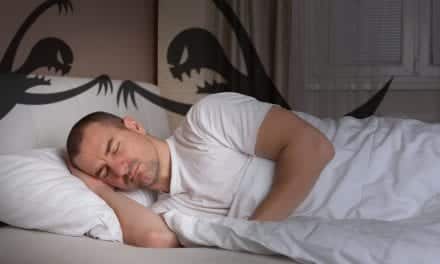A 60-year-old patient with REM behavior disorder benefited from sertraline, which made a marked difference in the frequency and violent nature of her dreams.

Pathophysiology
There is a body of convergent data suggesting the involvement of brainstem cholinergic neurons in the regulation of REM sleep and its atonia.4,5 Dysfunction of these neurons might therefore be implicated in the etiology of RBD. Albin et al6 found loss of dopaminergic midbrain neurons in chronic idiopathic RBD. They also hypothesized that RBD also could result from primary dysfunction of the pedunculopontine nucleus or other key brainstem structures with temporally correlated pathology occurring within the basal ganglia. Based on an animal (cat) model,7 disruption of the dorsal pontine tegmentum leading to a loss of normal REM sleep inhibition of the spinal alpha motoneurons via the descending medullary reticular formation was proposed to be a likely pathology; however, in humans, a structural neuropathology is not necessary for RBD because most patients do not have an identifiable neurological disorder. Turner and colleagues8 postulated that pathologic substrate of idiopathic RBD may involve neuronal loss and Lewy bodies in brainstem monoaminergic nuclei—particularly substantia nigra and locus coeruleus—that regulate REM sleep phenomena by modulation of cholinergic pedunculopontine neuronal activity; however, the exact pathophysiology of this parasomnia is unknown.
Epidemiology and Clinical Features
The true prevalence of RBD is not known. It is diagnosed most often in the sixth or seventh decade of life. This disorder often is familial. Most are men, and as many as 60% of patients presenting to sleep clinics may have a positive family history. It is estimated that REM sleep behavior disorder has an overall prevalence rate of 0.5%.9
The presenting complaint is violent dream-enacting behaviors during sleep, often causing self-injury or injury to the bed partner. The dream-enacting behaviors are usually nondirected and may include punching, kicking, leaping, or running from bed while still in sleep. In contrast to sleep walking, homicide associated with RBD has not been reported.10 RBD usually affects older men; nearly 60% of RBD patients have symptomatic RBD, with the onset being linked with the emergence of narcolepsy; neurodegenerative, cerebrovascular, or other neurologic disorders; and other conditions. The nocturnal neurobehavioral features of RBD almost always precede the daytime neurobehavioral features of dementia, often by several years. RBD has been reported with various neurodegenerative disorders, most frequently in disorders with Lewy body pathology. RBD often precedes the onset of Parkinson’s disease (PD), and a recent prospective study showed that 38% of patients with RBD eventually developed PD.11-13 As per Matheson and Saper,14 idiopathic RBD should be considered to represent a “preparkinsonian” state and RBD could provide a window of therapeutic opportunity for the development of neuroprotective strategies. Besides PD, RBD has been documented to precede or to co-occur with multiple-system atrophy (MSA), dementia with Lewy bodies (DLB),15-18 and spinocerebellar ataxia type 3.19 In one study, clinical symptoms of RBD preceded the onset of MSA by >1 year in 44% of the patients evaluated.20 In some cases, the clinical features of RBD tend to decrease in severity as the disease progresses. Neuropsychiatric features such as visual hallucinations and delusions are common. Fluctuations in cognition or alertness occur in almost every case. Variable degrees of Parkinsonism, static/postural tremor, and orthostatic hypotension are also frequent. Marked constructional dyspraxia and impaired verbal fluency are prominent. Attention/concentration deficits are also common and verbal memory and retention deficits occur variably. These core clinical and neuropsychometric features do not significantly differ between patients with and without Parkinsonism. The dementia associated with RBD is distinct from Alzheimer’s dementia (AD). Patients with RBD/dementia show significantly greater deficits in attention/concentration, perceptual organization, visual memory, and letter fluency than patients with AD.21 Patients with AD show significantly greater impairment in verbal memory and confrontation naming than do patients with RBD/dementia.21 Authors of another study found short- and long-term verbal visual memory deficit in about 40% of RBD patients; 25% of patients were also impaired on frontal lobe measures such as executive problem solving or verbal associative fluency.22 “Subclinical” or “preclinical” RBD, with frank RBD developing months or years later, has been also described in literature.23,24 These patients have a rather minimal parasomnia history, yet polysomnography (PSG) reveals increased phasic and/or tonic electromyographic (EMG) activity during REM sleep.23,24 In retrospective series of patients with both dementia and RBD, the great majority (92% to 94%) met criteria for possible or probable DLB.25,26 Boeve and colleagues27 suggest that RBD should be added as one of the core clinical criteria for the diagnosis of DLB, with any two of the following features meeting criteria for probable DLB: visual hallucinations, fluctuating cognition, Parkinsonism, and RBD. This abnormality may also be a useful criterion in the premorbid discrimination of DLB from other dementias. The neurologic examination findings are unremarkable in idiopathic cases; in secondary cases, the physical findings depend on the underlying disorder. The relationship between RBD and neuropsychological deficits is still unclear.
Case History
A 60-year-old-woman was brought to my office by her husband. She was described to have violent movements during her sleep. She described them as dreams where she was fighting a burglar who was trying to steal her purse and she would run after him and hit the wall. In the morning, she would find herself on the floor black and blue. At one time, she had a large bruise around her eyes. At other times, she had bruises on her arms and legs. She burned her arm when she hit the side table lamp on occasion and screamed obscenities and hit, kicked, and punched her husband. She explained that she thought she was hitting the burglar or fighting the intruder in her room. She also described having violent dreams of fighting with a bear or an attacker. She had these symptoms for approximately 10 years off and on. These symptoms occurred during the last half of the night when she acted out her dreams. These episodes were worse when she was under stress or pain from arthritis. She had no history of head trauma, stroke, dementia, seizure disorder, or PD. She had no history of sleep walking during her childhood, and her sleep study was unrevealing. She had a history of difficulty falling asleep, which she described as an age-related decreased need for sleep. Neurological evaluation was obtained, which included a CT scan of the brain and magnetic resonance imaging, which were normal, except for age-related brain atrophy, as well as an EEG, which was normal.
She was advised to take environmental precautions including locking the windows and doors and keeping sharp objects and electrical equipment out of her reach; her husband slept in a separate room. She was treated with clonazepam at 0.25 to 0.5 mg taken at bedtime. The frequency of RBD events decreased but still persisted; hence, she was given a low dose of sertaline up to 50 mg at sleep. Sertaline made a marked difference in the frequency and violent nature of her dreams.
Diagnostic Criteria
The diagnosis of RBD requires polysomnographic monitoring, with the hallmark EMG findings being the loss of generalized muscle atonia of REM sleep or prominent phasic muscle twitching in REM sleep, or both. According to the ICSD, the minimal diagnostic criteria include movements of the body or limbs associated with dreaming and at least one of the following criteria: potentially harmful sleep behavior, dreams that appear to be acted out, and sleep behavior that disrupts sleep continuity (American Sleep Disorders Association, 1997).1
The other diagnostic features of RBD include prominent limb or truncal jerking and complex, often violent behavior associated with dream recall, either observed at home or during PSG; PSG evidence during REM sleep of elevated tonic or phasic submental or limb tone on EMG; and the absence of EEG epileptiform activity during REM sleep.1,28
Management and drug treatment
RBD is treated symptomatically by various medications; however, the response varies in individual cases. Therefore, all available medications should be tried before considering the patient’s RBD as intractable. Management of RBD since its description has been mainly symptomatic. Early studies showed that clonazepam is effective, and it remains the most widely used therapy to date and the drug of choice. The use of clonazepam for patients with RBD evolved from its use since the 1970s to manage restless legs syndrome.29 Clonazepam is highly effective in the treatment of RBD. It is effective in nearly 90% of patients with little evidence of tolerance or abuse.30,31 The response usually begins within the first week, often on the first night. The initial dose is 0.5 mg at bedtime. The treatment should be continued indefinitely, as violent behaviors and nightmares relapse promptly with discontinuation of medications in almost all patients; however, the mechanism of action of clonazepam in patients with RBD is not understood.
Melatonin also was reported to be effective in treatment of RBD.32,33 In an open-labeled trial, six consecutive RBD patients were treated with 3 mg melatonin given within 30 minutes before bedtime over a 6-week period.32 There was a dramatic clinical improvement in five of the six patients within a week, which extended beyond the end of treatment for weeks or months. A second polysomnogram performed 6 weeks after the beginning of treatment showed a significant tendency toward normalization of the percentage of REM sleep. Symptoms of RBD can be ameliorated by an intervention that enhances cholinergic neurotransmission. Ringman and Simmons34 reported three patients with parasomnias consistent with RBD who had diminution of their RBD symptoms after treatment with donepezil, an acetyl cholinesterase inhibitor. As mentioned above, a large proportion of patients with RBD eventually develop a Parkinsonian syndrome. Levodopa was reported to improve subjective symptoms of RBD in three patients with PD, but the study did not provide PSG data.35 Fantini et al36 evaluated the effects of pramipexole, a D2-D3 preferring receptor agonist, on clinical symptoms and video-PSG characteristics of idiopathic RBD. Pramipexole produced sustained improvement of the clinical symptoms for five of eight patients, which further supports the notion of a common pathophysiologic mechanism underlying the two conditions.
Besides pharmacological intervention, another important aspect of management of patients with RBD is environmental safety. Potentially dangerous objects should be removed from the bedroom, and the mattress should be placed on the floor or a cushion should be put around the bed. Also, appropriate recognition and treatment can avoid dangerous injuries and their medical-legal consequences. Sleep medicine experts have been requested to testify in medical-legal cases. Educational efforts have been made to attract the attention of physicians about the problem, its medical-legal implications, and the need for appropriate documentation of the medical problems associated with the reported violence. The absence of full alertness or impairment of brain function due to associated sleep disorders has been considered a legal defense in crimes and homicides. The legal defense of sleep-related abnormal behavior has been that the harmful act is committed under a state of sleep rendering the individual not responsible or accountable for that action. Therefore, a systematic evaluation of these cases must be performed and properly documented.
Several medications have been linked to REM sleep behavior disorder, including selegiline, venlafaxine, donepezil, fluoxetine, tricyclic antidepressants, barbiturate withdrawal, bisoprolol, and mirtazapine.37-44 These medications should be avoided when a case of RBD is suspected.
Conclusion
RBD is a parasomnia of unknown etiopathogenesis characterized by complex motor activity associated with dream mentation and is often associated with various sleep and neurologic disorders. On PSG recording, patients with RBD show a loss of REM sleep muscle atonia, an excessive phasic motor activity during REM sleep, or both. To diagnose this disorder, specific interviews of the patient and the caregiver are essential besides PSG. Since the impact of RBD and sleep-related injury is considerable on both the patient and the caregiver, a systematic evaluation of these cases must be performed and properly documented. Clonazepam is currently the medication of choice and is very effective. RBD could provide a window of therapeutic opportunity for the development of neuroprotective strategies.
Naseer Masoodi, MD, is a fellow in geriatric medicine, SUNY at Buffalo, NY; Taj M. Jiva, MD, is a diplomate of the American Board of Sleep Medicine, and director of the Sleep Disorders Clinic, Orchard Park, NY.
References
1. American Sleep Disorders Association. International Classification of Sleep Disorders: Diagnostic and Coding Manual. Rochester, Minn: American Sleep Disorders Association; 1990.
2. Schenck CH, Bundlie SR, Ettinger MG, Mahowald MW. Chronic behavioral disorders of human REM sleep: a new category of parasomnia. Sleep. 1986;9:293-308.
3. Schenck CH, Mahowald MW. REM sleep parasomnias. Neurol Clin. 1996;14:697-720.
4. Shiromani PJ, Gillin JC, Henriksen SJ. Acetylcholine and the regulation of REM sleep: basic mechanisms and clinical implications for affective illness and narcolepsy. Ann Rev Pharmacol Toxicol. 1987;27:137-156.
5. Jones BE. The organization of central cholinergic systems and their functional importance in sleep-waking states. Prog Brain Res. 1993;98:61-71.
6. Albin RL, Koeppe RA, Chervin RD, et al. Decreased striatal dopaminergic innervation in REM sleep behavior disorder. Neurology. 2000;55:1410-1412.
7. Hendricks JC, Morrison AR, Mann GL. Different behaviors during paradoxical sleep without atonia depend on the pontine lesion site. Brain Res. 1982;239:81-105.
8. Turner R, D’Amato C, Chervin R, Blaivas M. The pathology of REM sleep behavior disorder with comorbid Lewy body dementia. Neurology. 2000;55:1730-1732
9. Ohayon MM, Caulet M, Priest RG. Violent behavior during sleep. J Clin Psychiatry. 1997;58:369-376
10. Mahowald MW, Bundlie SR, Hurwitz TD, Schenck CH. Sleep violence—forensic science implications: polygraphic and video documentation. J Forensic Sci. 1990;35:413-32
11. Boeve BF, Silber MH, Ferman TJ, et al. REM sleep behavior disorder and degenerative dementia: an association likely reflecting Lewy body disease. Neurology. 1998;51:363-370.
12. Silber M, Ahlskog J. REM sleep behavior disorder in parkinsonian syndromes [abstract]. Sleep Res. 1992;21:313.
13. Schenck C, Mahowald M. Delayed emergence of a parkinsonian disorder in 38% of 29 older males initially diagnosed with idiopathic REM sleep behavior disorder. Neurology. 1996;46:388-39
14. Matheson JK, Saper CB. REM sleep behavior disorder: a dopaminergic deficiency disorder? Neurology. 2003;61:1328-1329.
15. Comella C, Tanner C, Ristanovic R. Polysomnographic sleep measures in Parkinson’s disease patients with treatment-induced hallucinations. Ann Neurol. 1993;34:710-714.
16. Ferman T, Boeve B, Smith G, et al. REM sleep behavior disorder and dementia: cognitive differences when compared with AD. Neurology. 1999;52:951-957.
17. Perry R, Irving D, Blessed G, Fairbairn A, Perry EK. Senile dementia of Lewy body disease. A clinically and neuropathologically distinct form of Lewy body dementia in the elderly. J Neurol Sci. 1990;95:119-139.
18. Turner R, Chervin R, Frey K, Minoshima S, Kuhl D. Probable diffuse Lewy body disease presenting as REM sleep behavior disorder. Neurology. 1997;49:523-527.
19. Syed BH, Rye DB, Singh G. REM sleep behavior disorder and SCA-3 (Machado-Joseph disease). Neurology. 2003;60:148.
20. Plazzi G, Corsini R, Provini F, et al. REM sleep behavior disorders in multiple system atrophy. Neurology. 1997;48:1094-1099.
21. Ferman T, Boeve B, Smith G, et al. REM sleep behavior disorder and dementia: cognitive differences when compared with AD. Neurology. 1999;52:951–957.
22. Cox S, Risse G, Hawkins J, Schenck C, Mahowald M. Neuropsychological data in 34 patients with REM sleep behavior disorder (RBD). Sleep Res. 1990;19:206.
23. Schenck C, Mahowald M. REM sleep behavior disorder: clinical, developmental, and neuroscience perspectives 16 years after its formal identification in sleep. Sleep. 2002;25:120-138.
24. Gagnon JF, Medard MA, Fantini M, et al. REM sleep behavior disorder and REM sleep without atonia in Parkinson’s disease. Neurology. 2002;59:585-589.
25. Boeve BF, Silber MH, Ferman TJ, et al. REM sleep behavior disorder and degenerative dementia. An association likely reflecting Lewy body disease. Neurology. 1998;51:363-370.
26. Ferman TJ, Boeve BF, Smith GE, et al. REM sleep behavior disorder and dementia: cognitive differences when compared with AD. Neurology 1999;52:951-957.
27. Boeve BF, Silber MH, Parisi JE, et al. Synucleinopathy pathology and REM sleep behavior disorder plus dementia or parkinsonism. Neurology. 2003;61:40-45.
28. Mahowald M, Schenck C. REM sleep behavior disorder. In: Kryger M, Roth T, Dement W, eds. Principles and Practice of Sleep Medicine. 2nd ed. Philadelphia: WB Saunders; 1994:574-588.
29. Matthews WB. Treatment of the restless legs syndrome with clonazepam. BMJ. 1979;1:751.
30. Schenck CH, Mahowald MW. Long-term, nightly benzodiazepine treatment of injurious parasomnias and other disorders of disrupted nocturnal sleep in 170 adults. Am J Med. 1996;100:333-337.
31. Olson EJ, Boeve BF, Silber MH. Rapid eye movement sleep behaviour disorder: demographic, clinical and laboratory findings in 93 cases. Brain. 2000;123:331-339.
32. Kunz D, Bes F. Melatonin as a therapy in REM sleep behavior disorder patients: an open-labeled pilot study on the possible influence of melatonin on REM-sleep regulation. Mov Disord. 1999;14:507-511.
33. Takeuchi N, Uchimura N, et al. Melatonin therapy for REM sleep behavior disorder. Psychiatry Clin Neurosci. 2001;55:267-269.
34. Ringman JM, Simmons JH. Treatment of REM sleep behavior disorder with donepezil: a report of three cases. Neurology. 2000;55:870-871.
35. Tan A, Salgado M, Fahn S. Rapid eye movement sleep behavior disorder preceding Parkinson’s disease with therapeutic response to levodopa. Mov Disord. 1996;11:214-216.
36. Fantini ML, Gagnon JF, Filipini D, Montplaisir J. The effects of pramipexole in REM sleep behavior disorder. Neurology. 2003;61:1418-1420.
37. Louden MB, Monehead MA, Schmidt HS. Activation by selegiline (Eldepryde) of REM sleep behavior disorder in parkinsonism. West Virg Med J. 1995;91:101.
38. Schutte S, Doghrami K. REM sleep behavior disorder seen with venlafaxine (Effexon). Sleep Res. 1996;25:364.
39. Ross JS, Shua-Haim JM. Aricept-induced nightmares in Alzheimer’s disease: two case reports. J Am Geriatr Soc. 1998;46:119-120.
40. Schenck CH, Mahowald MW, Kim SW, et al. Prominent eye movements during NREM sleep and REM sleep behavior disorder associated with fluoxetine treatment of depression and obsessive-compulsive disorder. Sleep. 1992;15:226-235.
41. Bental E, Lavie P, Sharf B. Severe hypermotility during sleep in treatment of cataplexy with clomipramine. Israel J Med Sci. 1979;15:607-609.
42. Silber MH. REM sleep behavior disorder associated with barbiturate withdrawal. Sleep Res. 1996;25:371.
43. Iranzo A, Santamaria J. Bisoprolol-induced rapid eye movement sleep behavior disorder. Amer J Med. 1999;107:390-392.
44. Onofrj M, Luciano AL, Thomas A, Iacono D, D’Andreamatteo G. Mirtazapine induces REM sleep behavior disorder (RBD) in parkinsonism. Neurology. 2003;60:113-115.




